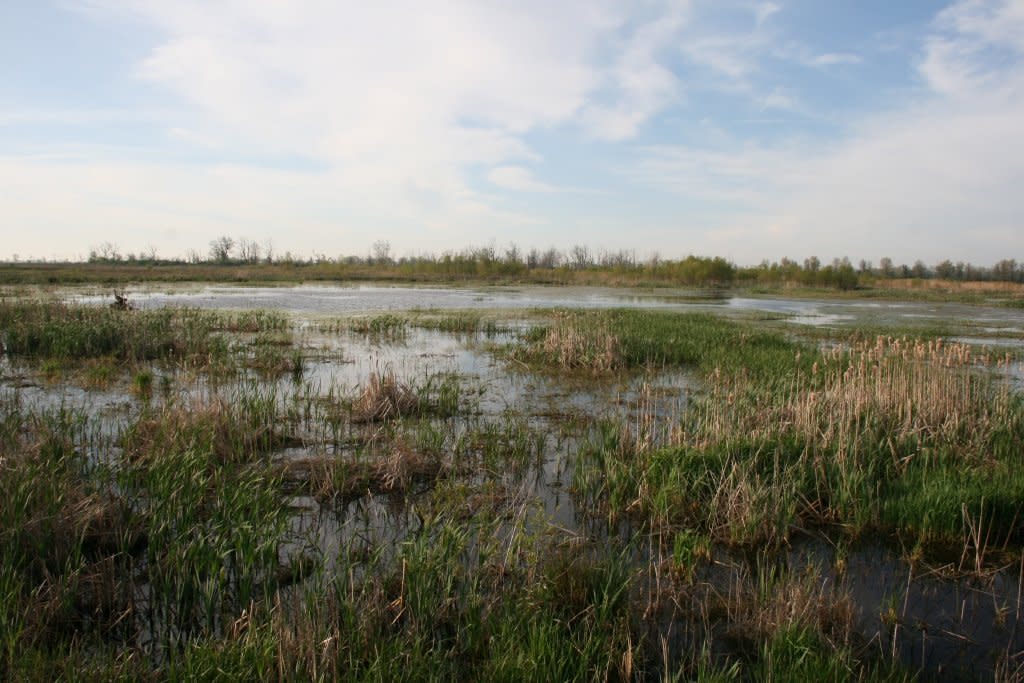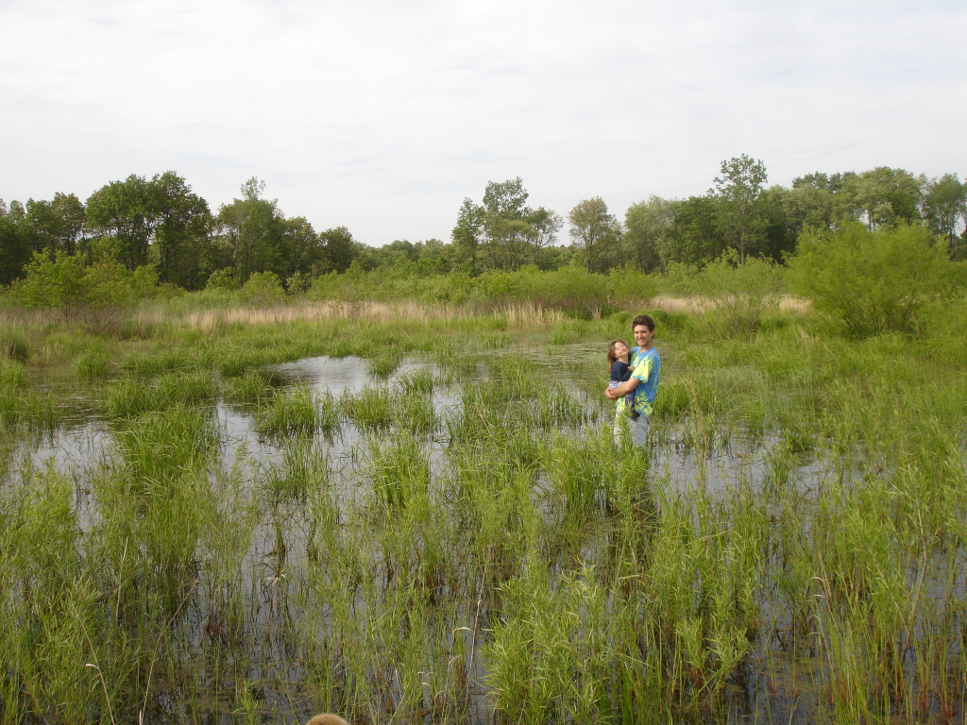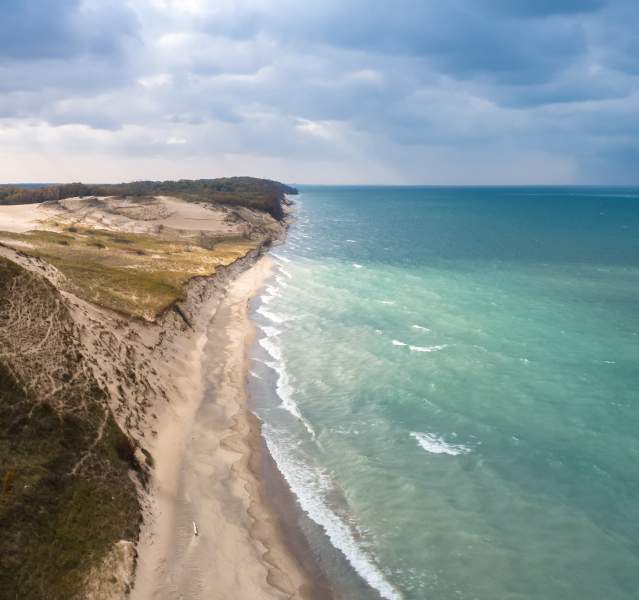There’s something about having your feet in water that is a thrill. As a kid, I jumped and splashed in puddles and ponds just to see how big an impact I could have. Now, as an adult, I enjoy watching kids jump and splash, but my way is different now… I prefer to walk slowly through the water, studying the ways that my movements create ripples through the system, and observing all the creatures moving in the water. Even without the splashing, being in and around water is still a thrill.
I feel so lucky to get to work in wet places—planting native plants, harvesting seeds, and removing non-native plants. Most folks know that at Kankakee Sands we have been planting thousands of acres to native prairie. Unknown to some is that interspersed in all that prairie are many wet places and wet spaces of varying shapes and sizes.
At Kankakee Sands, we have natural ephemeral depressions which fill with water in the spring and dry up as the year progresses. These are the spaces without fish, where salamanders and fairy shrimp take advantage of a watery world that lasts only several months.
We have low spaces created by wallowing bison, which are shallow enough to hold water for just a short period of time in the spring. These are the places where turtles have laid their eggs. Soon the hatchlings will emerge and crawl off to more permanent waterways.
We also have deep wetlands created by backhoes and bulldozers which hold water all year long and are a stable place for waterfowl to stopover during migrations or stay and raise young.
 A Kankakee Sands wetland. Photo by Leonard Mak
A Kankakee Sands wetland. Photo by Leonard Mak
The water that fills our Kankakee Sands wetlands does not come from the sky above, it comes from the high-water table below. We estimate that nearly 1/3 of our total 8,000 acres at Kankakee Sands are wetland acres. Those wet acres support so much life. According to the US EPA, wetlands are on par with rainforests and coral reefs in terms of their productivity and the diversity of species within them. I believe it! Our Indiana Department of Natural Resources estimates that 7,000 species of plants grow in Indiana wetlands!
When walking in a wetland, there is so much to see, as noted by this poem penned by a young friend of mine for this very article:
There are backswimmers and sideswimmers and pokey ol’ snails Crawdads and little squirmy things that wriggle their tails River otter, muskrats, beaver and mink Deer and possum come in for a drink Birds skim the surface looking for a meal
Butterflies, too, keeping it real
Frogs galore, their calls make a chorus Thanks wetlands, for all you do for us!
Indeed, so much life!
At Kankakee Sands, we take great pride in our wetlands and know how important they are not just for plants and animals but also for people and our local communities. The US EPA estimates that an acre of wetland can store up to a million gallons of water! This water storage helps to minimize flooding during strong storm events, which we know have been happening more regularly in recent years. Wetlands, with the massive diversity of plants and roots that grow there, help to filter out pollutants from the water as it moves through the wetlands and into the aquifers from which we get our drinking water.
All wetlands across the entire state of Indiana, and the nation, are important. But not all wetlands are created equal. We must remember that no recreated human-made wetland can ever rival a natural wetland and its complex set of interrelationships between the plants and the animals in the wetland ecosystem. Wetlands are precious and must be protected. In Northwest Indiana, we remember the story of Beaver Lake, the largest lake and wetland complex of the Grand Kankakee Marsh—second only to the Florida everglades in terms of plant and animal abundance and diversity, that was drained in the early 1900s to make way for cattle grazing and agriculture. We’ll never be able to recreate that magical place, but we can honor it by creating and protecting wetlands today.
 My husband Gus and our daughter Savanna at the wetland at a Kankakee Sands wetland. Photo by A.Nyberg/TNC
My husband Gus and our daughter Savanna at the wetland at a Kankakee Sands wetland. Photo by A.Nyberg/TNC
I’ve read about the relaxation benefits of having an aquarium. I agree, but well, take a walk in a wetland, my friend. Now that is relaxing! The green rushes and sedges brushing together as they sway in the wind. The call of the frogs around you, the whirls of the dragonflies zipping past, the gentle slurp of a turtle slipping into the water. Bend near to the water’s surface and watch all the activity zipping around. Truly mesmerizing and meditative… all the benefits of an aquarium, but it’s free and you don’t have to clean out a tank!
Too many mosquitoes, you say? Good news! If you visit a wetland in the spring and you’ll be delighted to find the that the mosquitoes are still eggs and larvae, not flying adults that bite.
Grab those boots, or old tennis shoes, and head to a wetland near you to appreciate all it has to offer. Late spring and early summer are great times for a wetland walk. The Wet Prairie Trail in the north bison pasture at Kankakee Sands is currently open, while the bison are in the south pasture. This trail has natural low wet depressions, bison wallows, and a large ephemeral pond dug by a backhoe—all currently filled with water. By midsummer many of these shallow wetlands will have turned to moist mud, happy to rob you of one of your boots! So take the opportunity this spring to slip into the water, walking stick in hand—breathe in, breathe out—and enjoy being a part of the wetland ecosystem you just entered.
Alyssa Nyberg is a Restoration Ecologist at The Nature Conservancy’s Kankakee Sands, an 8,300-acre prairie and savanna habitat in Northwest Indiana, open every day of the year for public enjoyment. For more information about Kankakee Sands, visit www.nature.org/KankakeeSands or call the office at 219-285-2184.

